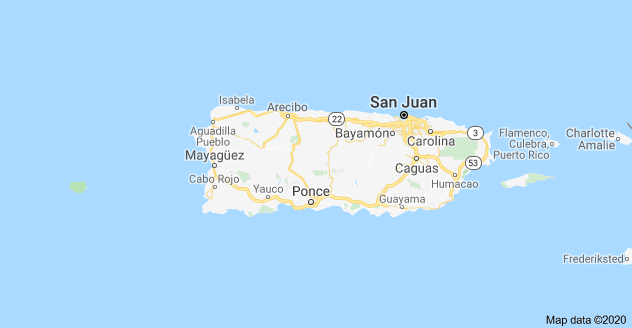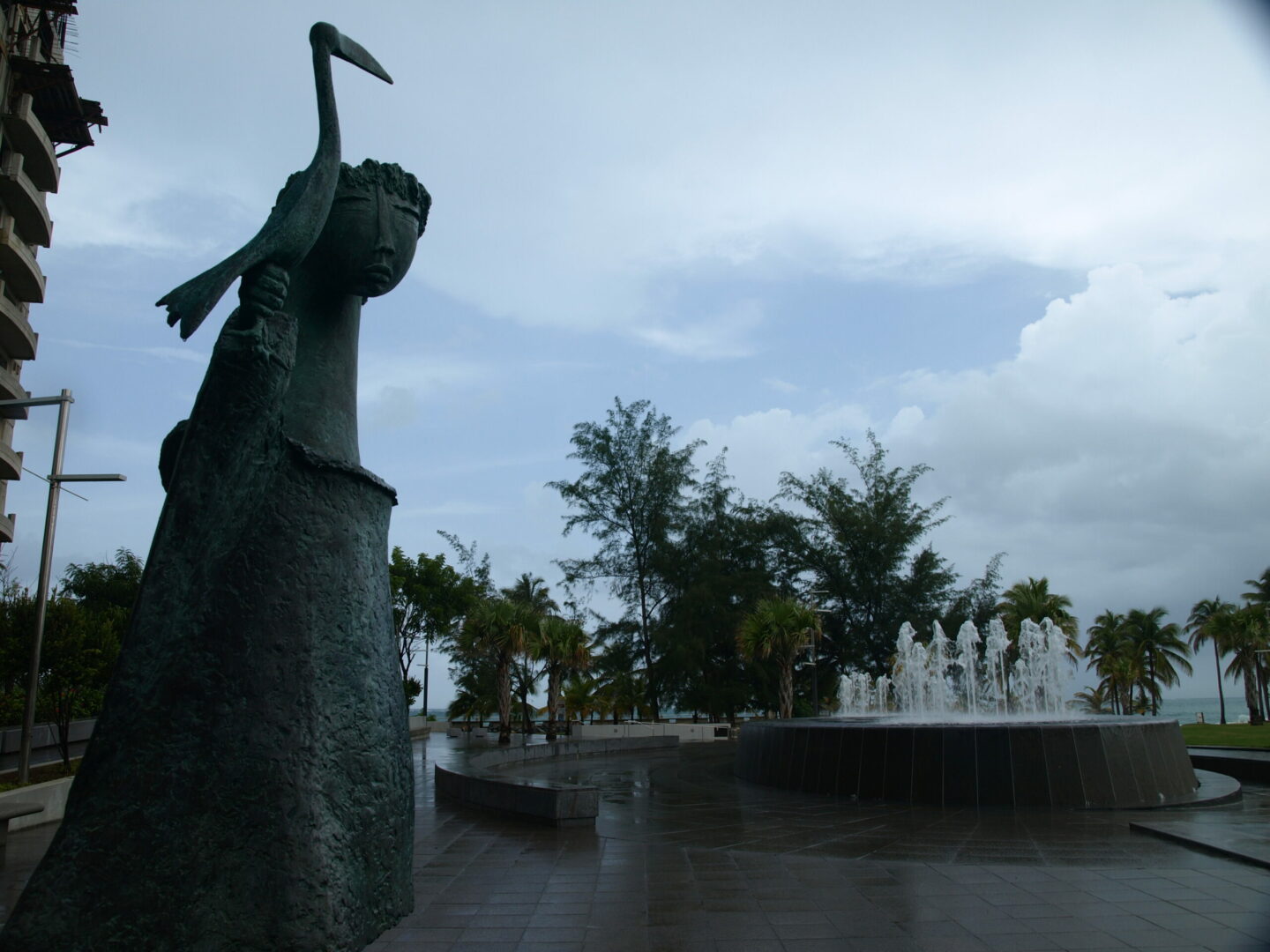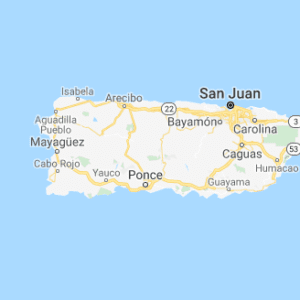Description
Puerto Rico General Tour:
2-2.5 hours
After pick up the tour begins in historical Old San Juan where you will forget that you are in the Caribbean in this heavily influenced Spanish Colonial and Continental architectural style; after all Rich Port was colonized by Spain for over 400 years before being ceded to America after the Spanish American War. Now populated by approximately 4 million Spanish, Boricua, African, and American nationality all mixed into one exotic type with their own dialectal foreign language and music making them the most foreign of Americans. The Roman style architecture of state buildings such as the Capitol Building is enough to satisfy even the most traveled travelers. We will visit the interior and drive up the coast of the great forts of Puerto Rico. This is an authentic experience which includes some samplings of Puerto Rican Spanish Cuisine.
Morning Tour
9:00 A.M. (on this tour schedule you can walk (optional) around Old San Juan from 11:30-1:30 +/- have lunch time and shopping time and be back to your ship or locale by 2:00 – 2:30 P.M.)
Afternoon Tour
12:00 P.M. (on this tour schedule you can swim (optional) from 2:30 +/- have a late swim until 3:30 and be back to your ship or locale by 4:00 P.M..
Adults- $75.00
Children (13 years and under) $55.00
(4 years and under Free- 2 maximum per couple)
Puerto Rico Locater
Puerto Rico: Named Rich Port by Ponce deLeon because of its gold and great potential agriculturally.
Located: 70 miles south west of St. Thomas U.S. Virgin Islands.
Size: 3,435 sq. ml. (110 miles east to west x 40 miles north to south) plus 1900 miles under water.
Capital: San Juan the capital was named in honor of San Juan Bautista of Spain.
Population: 4,000,000
Highest Elevation: Cordillera Central; 4,357 ft.
Annual Rainfall: 250 inches in the hills
Indigenous Palm: Silver Palm (Cocothrinax Alta)
National Flower: Hibiscus; Grandi Flora-malvaceae/ Maga Phestesia (Red Maga)
National Bird: Puerto Rican Parrot; Guaiaguau or Peperre and Piranous domin Roisenor (Red Falcon)
National Symbol: Coqui; a small frog that makes a melodious sound particularly at night and after rain that sounds like the phonetics of its name.
Language: Spanish, English
Religion: Catholicism (85%), Protestantism
Government: Puerto Rico is an American Common Wealth with self governing privileges that are within the laws of America and its Constitution.
Economy: An industrialized island with manufacturers of pharmaceuticals, petrochemicals, technology, and a strong tourism service and construction industries that support the base.
History: Puerto Rico was ceded to America in 1898 after the Spanish American War which started after the U.S.S Maine was blown up in Havana (Cuba) harbour. Cuba, Guantanamo Bay, Guam and the Philippines were also set free from Spanish control but Cuba became independent.
Puerto Rico Local Holidays
January 1st New Day Years
Saints January 6th
January 11th
February (third Monday)
February 18th
March 11th -Abolition
March 22nd
March (late) or April (early)-Good Friday
Easter
April 16th
May (Last Monday)
July 4th
July (Third Monday)
July 25th
July 27th
September (first Monday)
October (second Monday)
November 11th
November 19th Columbus Landing – November 19th
November (fourth Thursday)
Las Navidades -Middle of December through Jan 6th
December 24
December 25th
December 31 Carnival – late winter
Puerto Rico Historical Synopsis
Puerto Rico means Rich Port. Rich it was and still is. One of the most unique histories of all islands in the Caribbean, not just because of its size, but also of its historical dynamics.
Before being named in context by Christopher Columbus due to the ambitions and promise seen in its size it somehow proves that Christopher Columbus was truly ignorant of the world geography. His first visit in 1492 is when he really did believe that he found India proven by his return the following year and name Puerto Rico rich port not knowing that Hispaniola was larger and even more rich in potential. In 1493
Puerto Rico Timeline
1000 A.D.: Arawaks lived in Puerto Rico and called the island “Boriquen;” Land of the Brave Lord.
120 A.D.: Ciboney tribes lived in Puerto Rico. This is supported by carbon dating evidence.
1493: Columbus named Puerto Rico San Juan Bautista on November 19th.
1506: Settled by Spain.
1508: Juan Ponce de Leon became the first Spanish Governor and established Caparra.
1511: Ponce de Leon and his cohorts attacked the Arawaks after many such attacks, in another attempt to completely subdue them.
1520’s: Caparra was moved to Puerto Rico which was the name of another area nearby and that area was later named San Juan and became the capital and then the whole island was named Puerto Rico in later years.
1521: Ponce de Leon is killed in battle in Cuba.
1530: Hurricane
1537: Hurricane
1541: El Morro fortress was built to protect San Juan.
1550: Sugar cane production began to prosper.
1570 – 1594: Fortresses in San Juan were strengthened and others built around Puerto
Rico: El Boquerón, Santa Elana. These were built with the realization of Spain that Puerto Rico was a strategic military location for transporting goods to Europe.
1590: General Valdes era.
1595: Queen Elizabeth sent her very reliable sea faring warriors Sir Frances Drake and John Hawkins to Puerto Rico to recover lost treasure and gold that was stolen from them in the many battles in the Caribbean and South America. A large contingent of army ships and 4,000 men to ensure their victory but the El Morro Fortress and the many others were insurmountable; John Hawkins died in that battle and Sir Frances Drake was mortally wounded and fled; he escaped into the horizon.
1598: June 16th Earl of Cumberland a determined English privateer forced the governor of Puerto Rico (Mosquera) to surrender to the British. This attack pounded on the Spanish settlers for several days and was successful because of the duration when it was done he was unable to sustain control due to several diseases and revolt by the Spanish settlers who were still patriotic to Spain. Cumberland concluded defeat by default because he couldn’t kill all the settlers and burned many fields of plantations and stole gold and other Spanish loot before he fled into the horizon.
1625: September 24th 17 Dutch ships arrived and on the 30th attacked El Morro Fortress. The Dutch were defeated and fled by August 2nd.
1638: French took St. Croix and St. Martin.
1640: The governor of Puerto Rico tried to chase the French off of St. Croix which was Soon taken over by the Dutch.
1691: In Spain the Code of Laws of the Indies was established; based on the doctrine of royal absolutism which gave the governor; the chief executive promulgated decrees over the navy, army, fiscal authority, supreme judgeship, and ecclesiastical authority providing them the power over all aspects of the island on behalf of Spain.
1700’s: San Cristobal Fortress was built.
1718: Miguel Henriques fought the pirates at Crab Island he received the name Captain of Sea War/Provider of Corsairs of Puerto Rico.
1739: War of Jenkins Ear was culminated by many Spanish attacks on the British.
1750: There were still camps of Indian tribes that were basically ignored and left alone because of the surplus of Africans to do the hard work in the plantation
system which the Indians could not endure.
1765: Population is registered as 45,000.
1768: Hurricane hits Puerto Rico.
1773: Boston Tea Party occurred in Philadelphia.
1776: American Revolution.
1780: Hurricane hits Puerto Rico and prevents a major attack on Puerto Rico by the British.
1788: Hurricane.
1795: The revised Code of Spanish Laws was established; based on the doctrine of royal absolutism.
1797: Sir Ralph Abercrombie sailed to San Juan with a large fleet of ships and parked off of El Morro Fortress. They were carrying lots of gold and other loot from earlier attacks in Trinidad and with the Spanish putting up such a good sustainable fight for over 12 days into the month of April. The fear of possibly loosing their loot probably motivated them to flee into the horizon.
1800: Population 150,000.
1812: Spain granted Puerto Ricans citizenship under Governor Melendez Bruna on July 14th.
1815: The Spanish Crown issued a decree named Cedulade Gracias which repelled the mercantilist rules and promoted colonization by among other things lifting the tax on slaves and also offered grants to increase agricultural development.
1820: With England putting pressure on Spain to stop the slave trade in Africa slaves were brought in from nearby St. Thomas, St. Croix, and Tortola.
1820-96: Sugar cane production was always one of the traditional industries but with the turn from peasant farming to large estates and ranches reached its highest annual production. Later on in the 19th and early 20th centuries they turned to the growing tobacco agricultural industry. Starting in the late 20th and early 21st after America took over the island Americans started investing in the sugar industry and reaped huge profits in the 1920’s and 30’s supplanting coffee.
1823: South Americans that migrated to Puerto Rico were involved in independence movements back home and this energy and drive encouraged Puerto Ricans to seek more autonomy and their independence from Spain.
1859: Luis Munoz Rivera was born on July 17. He became a journalist, poet, politician and father of Munoz Marin.
1868: Puerto Ricans after 362 years of non progressive rule was ready for freedom and was lead by the passionate Ramon Betances in a revolt that was squashed by Spain. El grito de Lares a group of Puerto Ricans formed a declaration of independence and that was also squashed by Spain.
1873: March 11th slavery was supposedly abolished.
1887: Spain was practicing and administering strict and torturous oppressive tactics to control the press and the activities of the liberal political parties.
1896: This was a very volatile period with many locals desiring independence from Spain. Spain was not attending to their economic needs.
1897: A Charter of Autonomy was granted to Puerto Rico in November by Spain but that move towards more independence was short lived as America invaded the following year.
1898: In April the Spanish American War started after the U.S. lost a military ship in the harbour of Havana Cuba which was also controlled by Spain. In July 28th 3,400 U.S. troops invaded Puerto Rico and by December Puerto Rico was ceded to America. Spain had a spy headquarters in St. Thomas during the Spanish American War.
- Coffee became a major crop, replacing sugar.
1899: Population is 953,243
1900: Population 1,000,000. Foraker Act was passed to put land back into the hands of the people by limiting land to big corporations, but it also created a civil
government that prohibited elections by their own leaders. A huge population growth occurred from 1800 to present because the Spaniards fled Spanish colonies
that had wars going on for freedom and British rivalry.
1910: 3.6% of the population spoke English.
1916: Luis Munoz Rivera died on November 15th.
1917: Puerto Ricans were granted U.S. citizenship and the Puerto Rico Organic Act was passed that began the process towards Puerto Ricans electing their own governor.
1930’s: Depression era.
1932: The people rejected the Nacionalista Party at the polls while voting; they were lead by Pedro Al Campos.
1940: Munoz Marin’s political party; Political Democrats won the majority leadership in the new legislature. Munoz went on to work with Rexford Guy Tugwell between 1941- 46.
1941: Tugwell was appointed governor by Franklyn D. Roosevelt. Munoz and Tugwell worked towards Puerto Rico’s autonomy in controlling the infrastructure
such as the utilities and transportation system. They also started to divest the old plantation system by taking away illegally controlled land from the big
corporations and allowing peasants to cultivate it. They also sold plots with long term loans to native farmers.
1948: Munoz Marin was elected as the first governor on November 2, but wasn’t inaugurated until January 2, 1949. After Puerto Rico was ceded to America Luis
Munoz Marin’s administration saw to the exchange of money, skills and technical training from American businesses. This also involved Puerto Ricans migrating to New York for work in the different developing industries their in construction and the service industries. Income earned was in many instances sent home to families and further stimulated the economy by creating revenue ultimately to the government coffers.
1950’s: Fomento was formed by the Economic Development Administration which was supported by a Government Development Bank. The whole objective was to stimulate the economy by bringing subsidiaries of big industrial companies that were based in America and offering them incentives such as: long term income
tax exemptions, factories for sale or rent, even salaries for executives or professionals willing to train Puerto Ricans for the new jobs in the industries and
factories. This business development initiative was so successful that by 1966 created 1200 factories and 75,000 new jobs.
- The United States Congress passed Public Law 600 which would give Puerto Ricans the right to write their own constitution.
1952: Puerto Rico became a Common Wealth and the flag with five stripes (three red and two white) and one star signifying Puerto and three islands surrounding it: Culebra, Vieques Island and Mona Island.
1955: The main airport was opened in Carolina and was later changed to the Munoz Marin International Airport Governor Rafael Hernandez Colon in 1985.
1960’s: Puerto Rico’s industries were booming and the airport was receiving over a million visitors annually.
1964: 46% of the population spoke English.
1980: Population 3,634,021
2008: During the Democratic presidential nomination contest that lasted for over a Year; Hillary Clinton campaigned heavily in Puerto Rico despite the fact that
they were not able to vote in the presidential election. Hillary Clinton was trying to win the Super Delegates in Puerto Rico. Barack Obama was leading her in the important Super Delegate nomination process. Barack Obama also campaigned in Puerto Rico but was not able to get as much support from the
populace. Clinton went ahead to win Puerto Rico by 68% but lost the Democratic Nomination. Barack Obama became the first African to receive the Democratic
Nomination to the Presidency of the United States of America.





